Related sites:
Newsletter: Perspectives on Power Platform
Company: Niiranen Advisory Oy
You can do a lot with the configuration and customization toolkit that Microsoft Dynamics CRM offers. With the SDK and some lines of custom code, you can do almost anything. There in between lies the territory where the Dynamics CRM community is helping its members manage some of the commonly required tasks without the need for .NET developer resources. This is done through a wealth of wonderful, free tools that make it easier for anyone working with Dynamics CRM to access the power of the platform without getting their hands dirty in tweaking XML files or learning the right SDK calls.
Many of the tools listed here are a permanent fixture I take along with me to any consulting gig, while some are new entrants to the list. If you’ve been actively reading up the posts on various popular CRM blogs, you may well recognize most of them. However, while I personally spend far too much time on social media channels, I realize that not everyone in the industry has the luxury for such a lifestyle and may have therefore missed out on some tools that could have saved them hours worth of work. Therefore, I decided to compile a “Best Of” post to highlight the 10 tools no CRM consultant should be without. (For anyone wanting to stay on top of the latest tools and solutions I come across, you can either subscribe to my Dynamics CRM Links RSS feed or follow the Surviving CRM page on Google+.)
Download from CodePlex.
When setting up new user accounts in your Dynamics CRM organization, wouldn’t it be nice if the system administrator could set their personal settings to match the policies of the organization as well as the likely preferences of the user in question? Things like Time Zone, Records per Page, Advanced Find mode, default home page etc. can be easily configured for users in bulk with the CRM 2011 User Settings Utility by Amreek Singh.

One particular pet peeve of mine related to the default configuration of Dynamics CRM is that new contact records are automatically created from tracked email sender or recipient addresses not found in the database. Well, with this tool you can stop the users from unintentionally populating your database with partially filled contact records not associated to their proper parent accounts by simply configuring the setting to “No” for all users. Beats having to send everyone instructions by email on how to check their CRM profile settings, doesn’t it?
Download from Sonoma Partners website.
It’s not only the user settings that may require you to pop the hood open on your CRM instance. There is a number of Organization Settings as well as Deployment Settings that can be used to either overcome limitations or alter the default behavior of Dynamics CRM. For example, if you’d like to be able to export all of your contacts records from CRM to Excel and not just the first 10,000 then you’ll be happy to know that changing the MaxRecordsForExportToExcel parameter is a breeze with Universal Settings, no matter if you have an on-premises or CRM Online environment.
Another handy limit you can adjust with the tool is AggregateQueryRecordLimit, which will allow your charts to summarize more than 50,000 records at a time, instead of seeing “the maximum record limit is exceeded” errors. Also very handy if you wish to work with more than 50,000 marketing list members in your campaign target group. Unfortunately this tweak is not available for CRM Online, though, as the setting resides in the deployment table rather than the organization table, which is the only one you can update in the cloud.
We’re now stepping into the world of “Mr. CRM Tools” himself, a.k.a. Tanguy Touzard. His awesome Toolbox for Dynamics CRM 2011 is a collection of the various tools developed over the years to help make Dynamics CRM administration and customization more efficient and enjoyable. By downloading the Toolbox you’ll get a number of great tools, but just to ensure you understand why you need them, let me give a quick intro to my favorite ones.
Adjusting the CRM main page navigation (a.k.a. sitemap) is something that you should always perform after you’ve determined what are the entities your different user groups (sales, marketing, etc.) will need to access and what is the logical arrangement of them in the navigation. Trust me, the right answer is not “the order in which the entities were created” nor “alphabetical”. There’s a number of free sitemap editor tools out there, but since XrmToolbox is such a powerhouse, it makes a lot of sense to use the the same tool that you’ll be using for other tasks in the same organization, as you’ll only need to configure the connection parameters once.

Re-arrange, add, hide, group, rename, do basically whatever you want with the CRM menus with this editor without ever seeing a trace of the solution XML file contents.
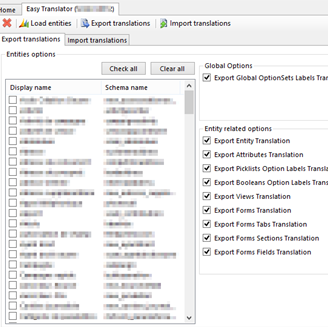 The latest addition to XrmToolbox is something every CRM admin from a non-English speaking country can surely appreciate. Since most of us still prefer to use the English base language setting in Dynamics CRM due to the awkward terminology of our native language translations in the customization UI (and any potential technical compatibility quirks that come with it), working with the “export/import labels for translation” process is all too familiar to us. Hunting down those strings in the unstructured output file isn’t very pleasant, which is where Easy Translator comes in handy. You’ll get a nicely arranged Excel with just the types of labels you’ve selected for export, which reduces the amount of trial & error in translating fields, values and form labels to the language of your choice.
The latest addition to XrmToolbox is something every CRM admin from a non-English speaking country can surely appreciate. Since most of us still prefer to use the English base language setting in Dynamics CRM due to the awkward terminology of our native language translations in the customization UI (and any potential technical compatibility quirks that come with it), working with the “export/import labels for translation” process is all too familiar to us. Hunting down those strings in the unstructured output file isn’t very pleasant, which is where Easy Translator comes in handy. You’ll get a nicely arranged Excel with just the types of labels you’ve selected for export, which reduces the amount of trial & error in translating fields, values and form labels to the language of your choice.
Not nearly many enough CRM customizers realize the impact of view layout design on the usability of the CRM system. If you don’t have the patience to design each view with just the right columns, then at least copy them over from another view so that the user experience is consistent. No, Dynamics CRM out of the box will not let you do that, but that missing “copy view columns” feature is covered by the View Layout Replicator in XrmToolbox.
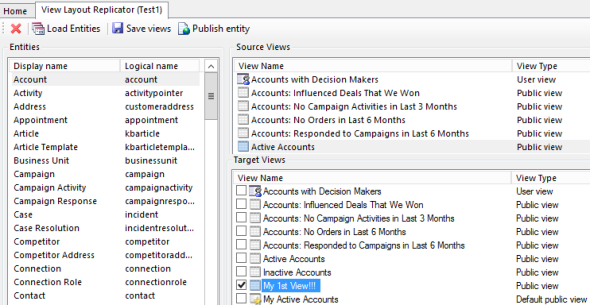
Just select your source view, then the views to which you want that layout to be copied to, click “save views”, “publish entity”, then go back to Facebook or whatever it is that you enjoy doing rather than clicking around in the entity view editor, ’cause we’re done over here!
Another pesky little task that I’m sure you just love to skip in your projects: turning off those unused default or legacy fields from your entities to stop them from showing up in Advanced Find and confusing the heck out of the poor end user. What used to be known as the Searchable Property Updater has now been upgraded to cover both the “searchable” as well as “auditing” settings. In order to set searchable only those fields included on your forms and disable everything else, all you need to do is select the entity, click “Valid for Advanced Find”, then “Check Attributes On Forms”. Save the attributes, publish your changes and go to AF for building a new view to discover a tidied up list of only the fields that are actually in use and could contain data worth searching for.
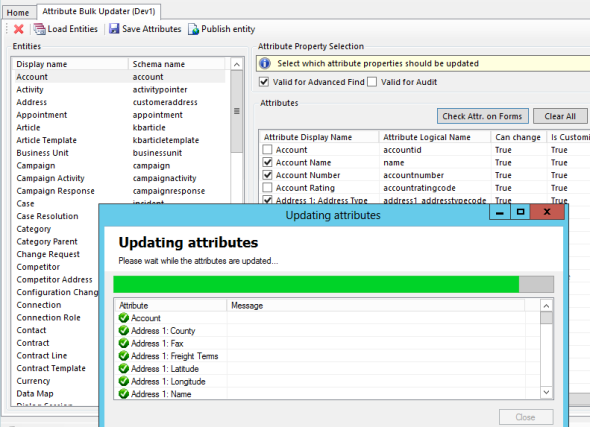
Everybody loves to write descriptions of entity configurations and data structure into Word or Excel to produce the piece of documentation that you’ve promised to deliver to the customer. Such a joyful task of replicating metadata already existing in the system, with absolutely no chance for errors of any kind in spelling the attribute names incorrectly and causing integration code to fail.
Don’t agree? Well, good for you, because your time is far too precious for such tasks. Let the Metadata Documentation Generator do the heavy lifting for you and produce an output of the selected entities’ attributes and all their central properties like schema name, type, field length and so on. After the tool is done you can start the real documentation work, i.e. describing why things are the way they are and how they relate to one another on a business process level.
Download from Develop 1 Limited blog.
Finally something not built by Tanguy, although judging by the high quality standards of the tool you’d be easily mistaken to believe otherwise. No, this time it’s the UK’s nr. 1 CRM Rockstar Scott Durow instead. Modifying the contents of the CRM 2011 Ribbon is one of the more complex tasks that a functional consultant may face, as the complexity behind all the show/hide and layout rules can be quite daunting. Why hasn’t Microsoft developed a graphical customization UI for this part of the application? Simple: because the perfect tool already exists and is freely available as a solution file you can import into your CRM organization. Once you’ve got it there, head on over to the Uservoice forums for Ribbon Workbench to read some helpful tutorials that demonstrate how to add, remove or modify the contents of the Ribbon to your heart’s content.
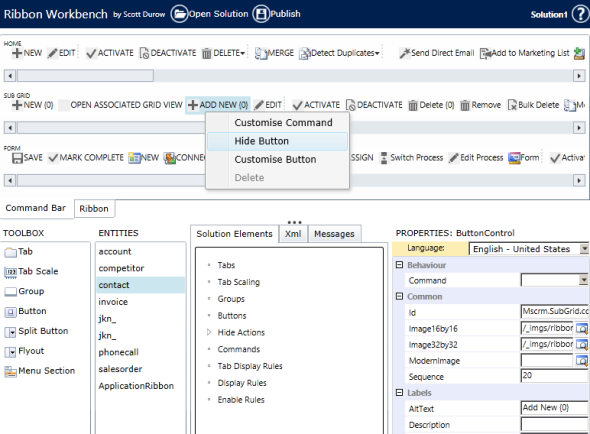
Are you thinking that the days of customizing the CRM 2011 ribbon are numbered as CRM 2013 is about to remove the ribbon from the refreshed UI? Think again, because Ribbon XML will remain the way how you customize the new Command Bars. Long before the product has even been released, Scott’s already created a CRM 2013 compatible version of the Ribbon Workbench, so all the skills you’ve acquired through using the tool will remain relevant once CRM 2013 or “Fall ’13” rolls out.
Download from Zero2Ten blog.
After you’re done customizing your CRM, you’ve imported your customer data and are ready to start working with the system, what if you realize that some data is actually in the wrong fields? You’re knowledgeable enough about workflow processes and realize that you could fix the data with an on-demand workflow rule, but the thought of applying the rule manually, 250 records at a time, to go over the tens of thousands of records in your CRM database makes you cringe. There’s gotta be an easier way to bulk edit more records than fit into a single view, you think to yourself, yet can’t seem to find a way around this platform limitation.
Thanks to Andy Popkin from Zero2Ten, we can now run workflow rules for basically any number of records. Just create an on-demand workflow rule, then a view of the records which the rule should be applied on, click “execute” in the tool and leave it running in the background. Take a coffee break, come back and see all of your records in that view having been processed and updated by the workflow rule. (Note: length of the coffee break will vary based on your server environment and number of records, so choose a Venti Frappuccino if you’re running this over Starbucks’ free Wi-Fi.)
Download from crmoptionset.com.
OK, one last tool before I let you go. Now we’re actually back in the Tanguy territory again, but since it’s not included in XrmToolbox I thought it would be worth mentioning here to ensure no one misses out on it. There’s actually a whole separate website for this tool, including a community library of option set values that anyone can contribute to. The concept is really simple: choose an Excel or CSV file with your option set values, choose the target attribute to which you want to import the values to, then – just import it!
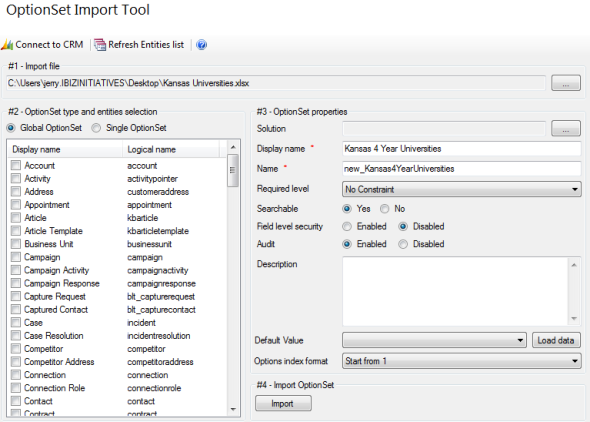
Another greatly missed button in the default customization UI has now been implemented as a free solution from the Dynamics CRM community. Where would we be without such great contributions?
If you’ve got any favorites to add to this list of Top 10 Tools for Microsoft Dynamics CRM, please feel free to leave a comment below and share them.
great list, thanks for bringing to light some new tools for me
Whoa!! Great post!
And thanks for talking about my tools!
Thanks for dominating the CRM Tools market, Tanguy 😉 You’ve set the bar quite high up for community contributed tools, but I’m hoping CRM 2013 will inspire new players to step in and publish some more utilities for improving the CRM system customization and management experience.
Gayan Perera’s CRM 2011 Web Resource Linker/Publisher – makes deploying and publishing web resource files from Visual Studio a breeze!
https://webresourcelinker.codeplex.com/team/view
hello
Thanks for this great resume,
I would also recommand a great tool for non dev consultant that need to build a ‘simple’ plug in.. from Amine Kouddane : http://easyplugins.codeplex.com/
enjoy !
Ivan
Anyone know if there is a tool to export the data found in the user settings utility?
David, at least I’m not aware of a tool to export the CRM user settings.
Also, I’ve heard that using the CRM 2011 User Settings Utility is not supported in CRM 2013 anymore. It does appear to work, though, but you’ll be risking your production system integrity by using it with the latest Dynamics CRM version.
If you’d like to see a centralized user settings management feature added into a future version of Dynamics CRM, please log on to MS Connect, join the Dynamics suggestions program and give your vote to this item: User Interface or Tool for CRM system administrator to update UserSettings.
Hi everyone!
Does anyone know if this tools (especially XrmToolBox) makes any changes directly to do CRM’s database?
Thank you!
MacLamas, I believe all of these tools are compatible with CRM Online, which means they can’t be directly performing any changes to the database but have to use the supported web services APIs instead.
I’m the developer of XrmToolBox and I can assure you there is never direct SQL changes. Everything goes through SDK API.
The source code is available on CodePlex and anyone can check on his own this statement
Hi Tanguy and Jukka,
Many thanks for your reply.
@Tanguy – It wasn’t my intention to disrespect you and your work. From your words I felt that you didn’t liked the question. If you didn’t, I present to you my apologies and rephrase that it was not or ever would be my intention to do so. I’m not a developer so I don’t have all the skills to analyse the code and infer that everything goes through SDK API.
I present to you my congratulations for this amazing work and to provide it to us.
Many thanks!
It´s my bad English… There was no problem with your question. No worries
XRM Tools Rocks!!!